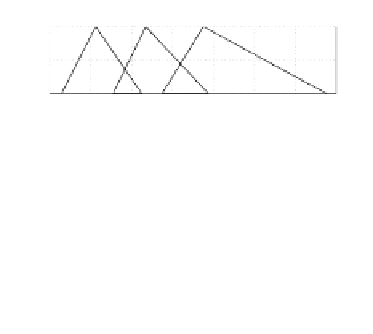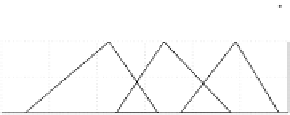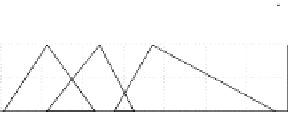Information Technology Reference
In-Depth Information
1
0.5
R1
R2
R3
0
−4
−2
0
2
4
6
8
10
Number of users
1
0.5
R2
R1
R3
0
−6
−4
−2
0
2
4
6
8
Area of villages(m
2
)
1
0.5
R2
R1
R3
0
−4
−2
0
2
4
6
8
10
Length of low voltage line(m)
Fig. 5.
Membership functions based on clustering projection and least square fitting
in each variable
The parameters of the fitness function in (1+1) ES is designed as follows:
ω
=0
.
05,
k
=0
.
1; the initial coecient of step is
σ
0
= 1; if the rate of success
is lower than 20%, the new coecient of step is got by
σ
i
+1
=
σ
i
∗
0
.
65 in the
(
i
+1) generation; Or else
σ
i
+1
=
σ
i
/
0
.
65; The maximum generation of evolution
is
g
= 100.
The generated Mamdani rule is described as follows:
R
i
:IF
x
1
is
A
1
and
x
2
is
A
2
,
THEN
y
i
is
B
i
,i
=1
,...,
3
(10)
The tuned membership functions are shown in Fig.6.
1
1
A
1
2
A
1
A
3
0.5
0
−4
−2
0
2
4
6
8
10
Number of users
1
2
A
1
A
2
3
A
2
0.5
0
−6
−4
−2
0
2
4
6
Area of villages(m
2
)
1
B
3
B
1
B
2
0.5
0
−4
−2
0
2
4
6
8
10
Length of low voltage line(m)
Fig. 6.
Tuned membership functions in each variable by (1+1) ES
As is shown in Fig.6., on the one hand, the overlapping area located in the
two adjacent membership functions in the domain of each variable is shortened;
on the other hand, the centers of the membership functions are easily to be
distinguished. As a result, the distinguishability of the original fuzzy partition
is improved.


















































































































































































































































Search WWH ::

Custom Search